Business Finance Report: Project Plan Analysis for Root and Cook Ltd
VerifiedAdded on 2020/06/04
|11
|3246
|295
Report
AI Summary
This business finance report provides a detailed financial analysis of Root and Cook Ltd's project plans. It begins with an introduction to business finance and then delves into the explanation of financial problems, including cash flow statements, profit and loss statements, working capital management, and the roles of receivables, inventories, and payables. The report then explores concepts subject to managing financial results, such as ratio analysis and the use of financial ratios to assess a company's performance. The second part of the report covers capital budgeting, its purpose, key steps, and investment appraisal methods. It compares alternative investment options, like ventures in Reading and Bristol, and offers analysis and recommendations regarding project plans. The report concludes with a summary of findings and recommendations, supported by references.

BUSINESS FINANCE
Paraphrase This Document
Need a fresh take? Get an instant paraphrase of this document with our AI Paraphraser

Table of Contents
INTRODUCTION...........................................................................................................................1
PART 1............................................................................................................................................1
1. Explanation of financial problems..........................................................................................1
2. Concepts subject to managing financial results......................................................................3
3. analysation and recommendation about the steps taken to improve company's cash flow.....4
PART 2............................................................................................................................................4
1. Capital budgeting purpose and key steps, investment appraisal methods..............................5
2. Compare the alternative investment option with practical example.......................................7
3. analysis and recommendation subject to project plan.............................................................8
CONCLUSION................................................................................................................................8
REFERENCES................................................................................................................................9
INTRODUCTION...........................................................................................................................1
PART 1............................................................................................................................................1
1. Explanation of financial problems..........................................................................................1
2. Concepts subject to managing financial results......................................................................3
3. analysation and recommendation about the steps taken to improve company's cash flow.....4
PART 2............................................................................................................................................4
1. Capital budgeting purpose and key steps, investment appraisal methods..............................5
2. Compare the alternative investment option with practical example.......................................7
3. analysis and recommendation subject to project plan.............................................................8
CONCLUSION................................................................................................................................8
REFERENCES................................................................................................................................9
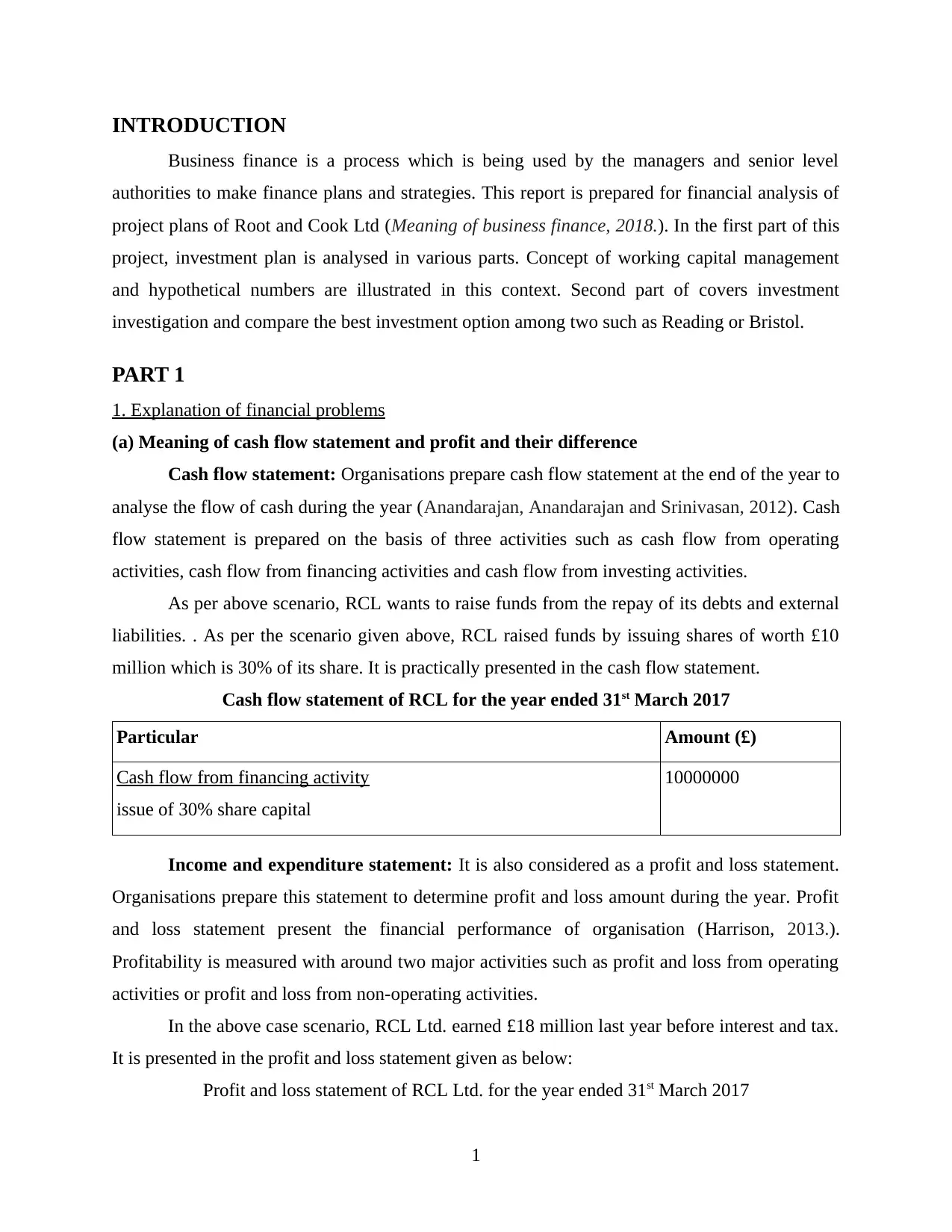
INTRODUCTION
Business finance is a process which is being used by the managers and senior level
authorities to make finance plans and strategies. This report is prepared for financial analysis of
project plans of Root and Cook Ltd (Meaning of business finance, 2018.). In the first part of this
project, investment plan is analysed in various parts. Concept of working capital management
and hypothetical numbers are illustrated in this context. Second part of covers investment
investigation and compare the best investment option among two such as Reading or Bristol.
PART 1
1. Explanation of financial problems
(a) Meaning of cash flow statement and profit and their difference
Cash flow statement: Organisations prepare cash flow statement at the end of the year to
analyse the flow of cash during the year (Anandarajan, Anandarajan and Srinivasan, 2012). Cash
flow statement is prepared on the basis of three activities such as cash flow from operating
activities, cash flow from financing activities and cash flow from investing activities.
As per above scenario, RCL wants to raise funds from the repay of its debts and external
liabilities. . As per the scenario given above, RCL raised funds by issuing shares of worth £10
million which is 30% of its share. It is practically presented in the cash flow statement.
Cash flow statement of RCL for the year ended 31st March 2017
Particular Amount (£)
Cash flow from financing activity
issue of 30% share capital
10000000
Income and expenditure statement: It is also considered as a profit and loss statement.
Organisations prepare this statement to determine profit and loss amount during the year. Profit
and loss statement present the financial performance of organisation (Harrison, 2013.).
Profitability is measured with around two major activities such as profit and loss from operating
activities or profit and loss from non-operating activities.
In the above case scenario, RCL Ltd. earned £18 million last year before interest and tax.
It is presented in the profit and loss statement given as below:
Profit and loss statement of RCL Ltd. for the year ended 31st March 2017
1
Business finance is a process which is being used by the managers and senior level
authorities to make finance plans and strategies. This report is prepared for financial analysis of
project plans of Root and Cook Ltd (Meaning of business finance, 2018.). In the first part of this
project, investment plan is analysed in various parts. Concept of working capital management
and hypothetical numbers are illustrated in this context. Second part of covers investment
investigation and compare the best investment option among two such as Reading or Bristol.
PART 1
1. Explanation of financial problems
(a) Meaning of cash flow statement and profit and their difference
Cash flow statement: Organisations prepare cash flow statement at the end of the year to
analyse the flow of cash during the year (Anandarajan, Anandarajan and Srinivasan, 2012). Cash
flow statement is prepared on the basis of three activities such as cash flow from operating
activities, cash flow from financing activities and cash flow from investing activities.
As per above scenario, RCL wants to raise funds from the repay of its debts and external
liabilities. . As per the scenario given above, RCL raised funds by issuing shares of worth £10
million which is 30% of its share. It is practically presented in the cash flow statement.
Cash flow statement of RCL for the year ended 31st March 2017
Particular Amount (£)
Cash flow from financing activity
issue of 30% share capital
10000000
Income and expenditure statement: It is also considered as a profit and loss statement.
Organisations prepare this statement to determine profit and loss amount during the year. Profit
and loss statement present the financial performance of organisation (Harrison, 2013.).
Profitability is measured with around two major activities such as profit and loss from operating
activities or profit and loss from non-operating activities.
In the above case scenario, RCL Ltd. earned £18 million last year before interest and tax.
It is presented in the profit and loss statement given as below:
Profit and loss statement of RCL Ltd. for the year ended 31st March 2017
1
⊘ This is a preview!⊘
Do you want full access?
Subscribe today to unlock all pages.

Trusted by 1+ million students worldwide
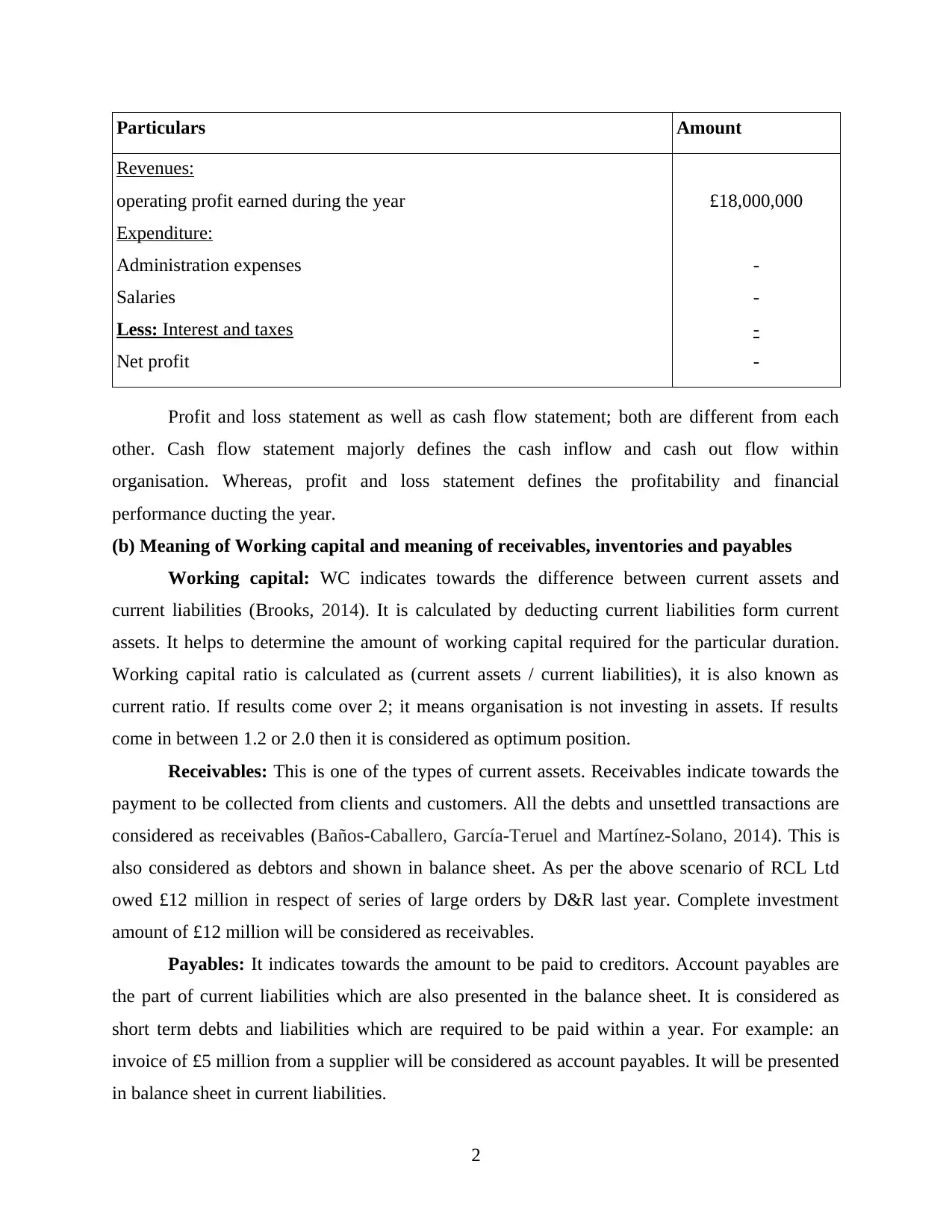
Particulars Amount
Revenues:
operating profit earned during the year
Expenditure:
Administration expenses
Salaries
Less: Interest and taxes
Net profit
£18,000,000
-
-
-
-
Profit and loss statement as well as cash flow statement; both are different from each
other. Cash flow statement majorly defines the cash inflow and cash out flow within
organisation. Whereas, profit and loss statement defines the profitability and financial
performance ducting the year.
(b) Meaning of Working capital and meaning of receivables, inventories and payables
Working capital: WC indicates towards the difference between current assets and
current liabilities (Brooks, 2014). It is calculated by deducting current liabilities form current
assets. It helps to determine the amount of working capital required for the particular duration.
Working capital ratio is calculated as (current assets / current liabilities), it is also known as
current ratio. If results come over 2; it means organisation is not investing in assets. If results
come in between 1.2 or 2.0 then it is considered as optimum position.
Receivables: This is one of the types of current assets. Receivables indicate towards the
payment to be collected from clients and customers. All the debts and unsettled transactions are
considered as receivables (Baños-Caballero, García-Teruel and Martínez-Solano, 2014). This is
also considered as debtors and shown in balance sheet. As per the above scenario of RCL Ltd
owed £12 million in respect of series of large orders by D&R last year. Complete investment
amount of £12 million will be considered as receivables.
Payables: It indicates towards the amount to be paid to creditors. Account payables are
the part of current liabilities which are also presented in the balance sheet. It is considered as
short term debts and liabilities which are required to be paid within a year. For example: an
invoice of £5 million from a supplier will be considered as account payables. It will be presented
in balance sheet in current liabilities.
2
Revenues:
operating profit earned during the year
Expenditure:
Administration expenses
Salaries
Less: Interest and taxes
Net profit
£18,000,000
-
-
-
-
Profit and loss statement as well as cash flow statement; both are different from each
other. Cash flow statement majorly defines the cash inflow and cash out flow within
organisation. Whereas, profit and loss statement defines the profitability and financial
performance ducting the year.
(b) Meaning of Working capital and meaning of receivables, inventories and payables
Working capital: WC indicates towards the difference between current assets and
current liabilities (Brooks, 2014). It is calculated by deducting current liabilities form current
assets. It helps to determine the amount of working capital required for the particular duration.
Working capital ratio is calculated as (current assets / current liabilities), it is also known as
current ratio. If results come over 2; it means organisation is not investing in assets. If results
come in between 1.2 or 2.0 then it is considered as optimum position.
Receivables: This is one of the types of current assets. Receivables indicate towards the
payment to be collected from clients and customers. All the debts and unsettled transactions are
considered as receivables (Baños-Caballero, García-Teruel and Martínez-Solano, 2014). This is
also considered as debtors and shown in balance sheet. As per the above scenario of RCL Ltd
owed £12 million in respect of series of large orders by D&R last year. Complete investment
amount of £12 million will be considered as receivables.
Payables: It indicates towards the amount to be paid to creditors. Account payables are
the part of current liabilities which are also presented in the balance sheet. It is considered as
short term debts and liabilities which are required to be paid within a year. For example: an
invoice of £5 million from a supplier will be considered as account payables. It will be presented
in balance sheet in current liabilities.
2
Paraphrase This Document
Need a fresh take? Get an instant paraphrase of this document with our AI Paraphraser
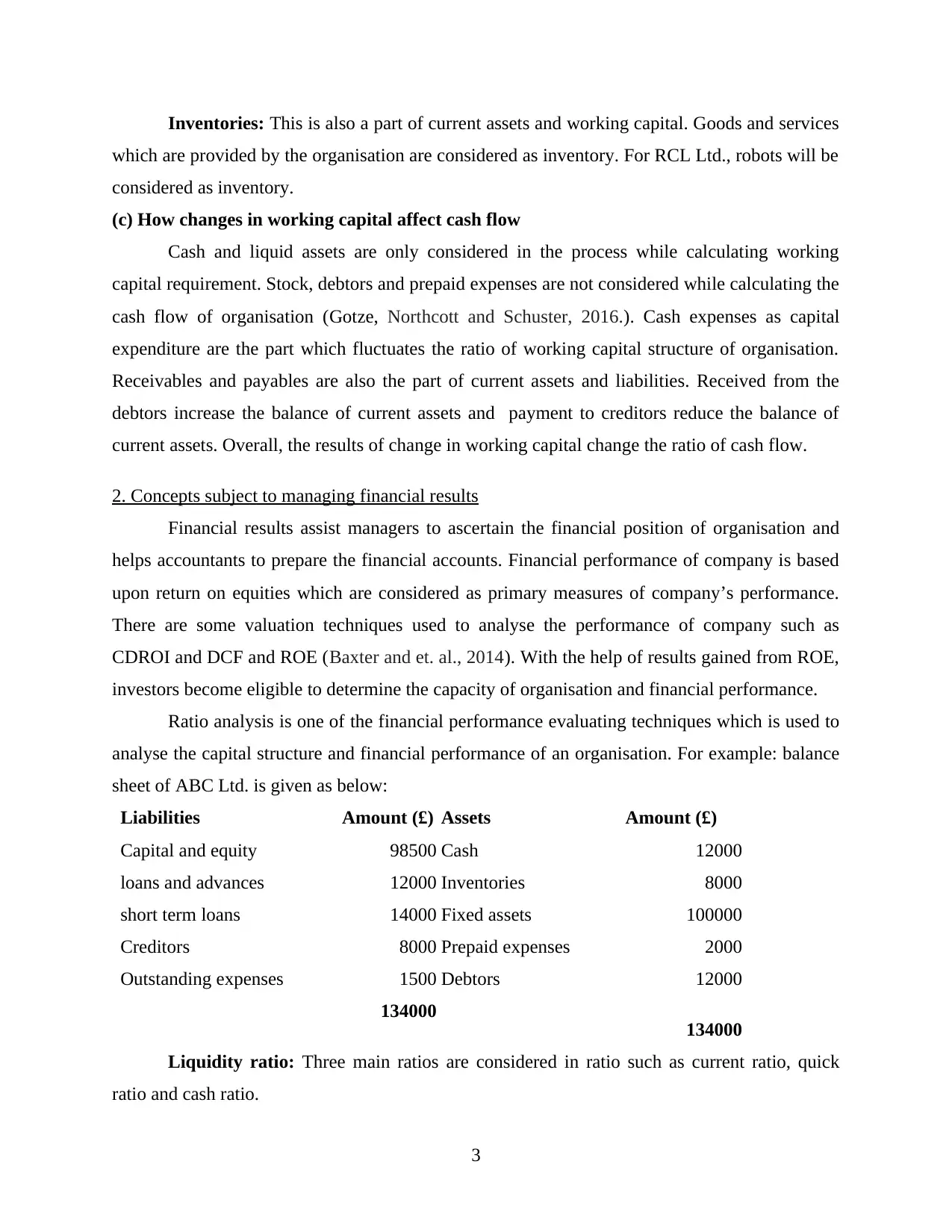
Inventories: This is also a part of current assets and working capital. Goods and services
which are provided by the organisation are considered as inventory. For RCL Ltd., robots will be
considered as inventory.
(c) How changes in working capital affect cash flow
Cash and liquid assets are only considered in the process while calculating working
capital requirement. Stock, debtors and prepaid expenses are not considered while calculating the
cash flow of organisation (Gotze, Northcott and Schuster, 2016.). Cash expenses as capital
expenditure are the part which fluctuates the ratio of working capital structure of organisation.
Receivables and payables are also the part of current assets and liabilities. Received from the
debtors increase the balance of current assets and payment to creditors reduce the balance of
current assets. Overall, the results of change in working capital change the ratio of cash flow.
2. Concepts subject to managing financial results
Financial results assist managers to ascertain the financial position of organisation and
helps accountants to prepare the financial accounts. Financial performance of company is based
upon return on equities which are considered as primary measures of company’s performance.
There are some valuation techniques used to analyse the performance of company such as
CDROI and DCF and ROE (Baxter and et. al., 2014). With the help of results gained from ROE,
investors become eligible to determine the capacity of organisation and financial performance.
Ratio analysis is one of the financial performance evaluating techniques which is used to
analyse the capital structure and financial performance of an organisation. For example: balance
sheet of ABC Ltd. is given as below:
Liabilities Amount (£) Assets Amount (£)
Capital and equity 98500 Cash 12000
loans and advances 12000 Inventories 8000
short term loans 14000 Fixed assets 100000
Creditors 8000 Prepaid expenses 2000
Outstanding expenses 1500 Debtors 12000
134000 134000
Liquidity ratio: Three main ratios are considered in ratio such as current ratio, quick
ratio and cash ratio.
3
which are provided by the organisation are considered as inventory. For RCL Ltd., robots will be
considered as inventory.
(c) How changes in working capital affect cash flow
Cash and liquid assets are only considered in the process while calculating working
capital requirement. Stock, debtors and prepaid expenses are not considered while calculating the
cash flow of organisation (Gotze, Northcott and Schuster, 2016.). Cash expenses as capital
expenditure are the part which fluctuates the ratio of working capital structure of organisation.
Receivables and payables are also the part of current assets and liabilities. Received from the
debtors increase the balance of current assets and payment to creditors reduce the balance of
current assets. Overall, the results of change in working capital change the ratio of cash flow.
2. Concepts subject to managing financial results
Financial results assist managers to ascertain the financial position of organisation and
helps accountants to prepare the financial accounts. Financial performance of company is based
upon return on equities which are considered as primary measures of company’s performance.
There are some valuation techniques used to analyse the performance of company such as
CDROI and DCF and ROE (Baxter and et. al., 2014). With the help of results gained from ROE,
investors become eligible to determine the capacity of organisation and financial performance.
Ratio analysis is one of the financial performance evaluating techniques which is used to
analyse the capital structure and financial performance of an organisation. For example: balance
sheet of ABC Ltd. is given as below:
Liabilities Amount (£) Assets Amount (£)
Capital and equity 98500 Cash 12000
loans and advances 12000 Inventories 8000
short term loans 14000 Fixed assets 100000
Creditors 8000 Prepaid expenses 2000
Outstanding expenses 1500 Debtors 12000
134000 134000
Liquidity ratio: Three main ratios are considered in ratio such as current ratio, quick
ratio and cash ratio.
3
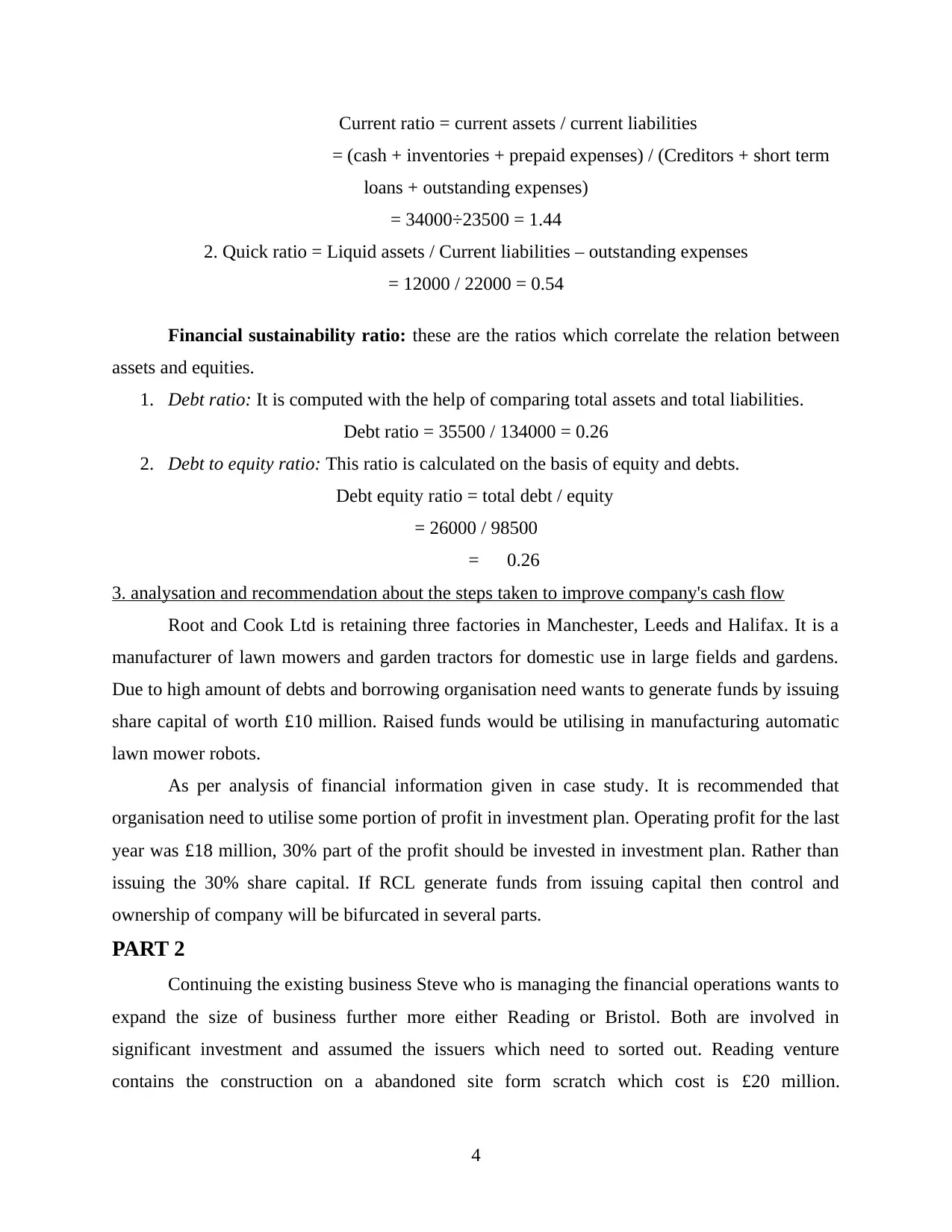
Current ratio = current assets / current liabilities
= (cash + inventories + prepaid expenses) / (Creditors + short term
loans + outstanding expenses)
= 34000÷23500 = 1.44
2. Quick ratio = Liquid assets / Current liabilities – outstanding expenses
= 12000 / 22000 = 0.54
Financial sustainability ratio: these are the ratios which correlate the relation between
assets and equities.
1. Debt ratio: It is computed with the help of comparing total assets and total liabilities.
Debt ratio = 35500 / 134000 = 0.26
2. Debt to equity ratio: This ratio is calculated on the basis of equity and debts.
Debt equity ratio = total debt / equity
= 26000 / 98500
= 0.26
3. analysation and recommendation about the steps taken to improve company's cash flow
Root and Cook Ltd is retaining three factories in Manchester, Leeds and Halifax. It is a
manufacturer of lawn mowers and garden tractors for domestic use in large fields and gardens.
Due to high amount of debts and borrowing organisation need wants to generate funds by issuing
share capital of worth £10 million. Raised funds would be utilising in manufacturing automatic
lawn mower robots.
As per analysis of financial information given in case study. It is recommended that
organisation need to utilise some portion of profit in investment plan. Operating profit for the last
year was £18 million, 30% part of the profit should be invested in investment plan. Rather than
issuing the 30% share capital. If RCL generate funds from issuing capital then control and
ownership of company will be bifurcated in several parts.
PART 2
Continuing the existing business Steve who is managing the financial operations wants to
expand the size of business further more either Reading or Bristol. Both are involved in
significant investment and assumed the issuers which need to sorted out. Reading venture
contains the construction on a abandoned site form scratch which cost is £20 million.
4
= (cash + inventories + prepaid expenses) / (Creditors + short term
loans + outstanding expenses)
= 34000÷23500 = 1.44
2. Quick ratio = Liquid assets / Current liabilities – outstanding expenses
= 12000 / 22000 = 0.54
Financial sustainability ratio: these are the ratios which correlate the relation between
assets and equities.
1. Debt ratio: It is computed with the help of comparing total assets and total liabilities.
Debt ratio = 35500 / 134000 = 0.26
2. Debt to equity ratio: This ratio is calculated on the basis of equity and debts.
Debt equity ratio = total debt / equity
= 26000 / 98500
= 0.26
3. analysation and recommendation about the steps taken to improve company's cash flow
Root and Cook Ltd is retaining three factories in Manchester, Leeds and Halifax. It is a
manufacturer of lawn mowers and garden tractors for domestic use in large fields and gardens.
Due to high amount of debts and borrowing organisation need wants to generate funds by issuing
share capital of worth £10 million. Raised funds would be utilising in manufacturing automatic
lawn mower robots.
As per analysis of financial information given in case study. It is recommended that
organisation need to utilise some portion of profit in investment plan. Operating profit for the last
year was £18 million, 30% part of the profit should be invested in investment plan. Rather than
issuing the 30% share capital. If RCL generate funds from issuing capital then control and
ownership of company will be bifurcated in several parts.
PART 2
Continuing the existing business Steve who is managing the financial operations wants to
expand the size of business further more either Reading or Bristol. Both are involved in
significant investment and assumed the issuers which need to sorted out. Reading venture
contains the construction on a abandoned site form scratch which cost is £20 million.
4
⊘ This is a preview!⊘
Do you want full access?
Subscribe today to unlock all pages.

Trusted by 1+ million students worldwide
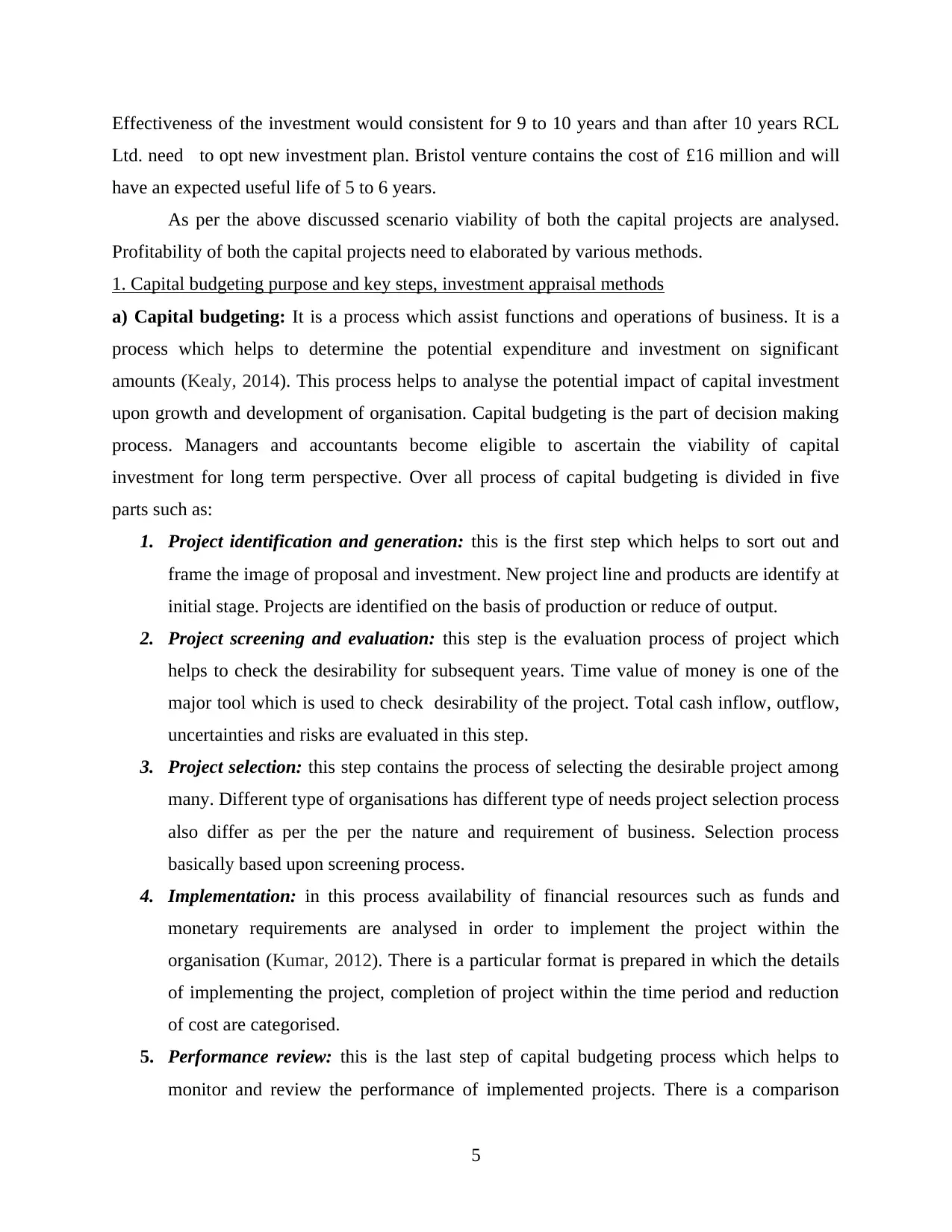
Effectiveness of the investment would consistent for 9 to 10 years and than after 10 years RCL
Ltd. need to opt new investment plan. Bristol venture contains the cost of £16 million and will
have an expected useful life of 5 to 6 years.
As per the above discussed scenario viability of both the capital projects are analysed.
Profitability of both the capital projects need to elaborated by various methods.
1. Capital budgeting purpose and key steps, investment appraisal methods
a) Capital budgeting: It is a process which assist functions and operations of business. It is a
process which helps to determine the potential expenditure and investment on significant
amounts (Kealy, 2014). This process helps to analyse the potential impact of capital investment
upon growth and development of organisation. Capital budgeting is the part of decision making
process. Managers and accountants become eligible to ascertain the viability of capital
investment for long term perspective. Over all process of capital budgeting is divided in five
parts such as:
1. Project identification and generation: this is the first step which helps to sort out and
frame the image of proposal and investment. New project line and products are identify at
initial stage. Projects are identified on the basis of production or reduce of output.
2. Project screening and evaluation: this step is the evaluation process of project which
helps to check the desirability for subsequent years. Time value of money is one of the
major tool which is used to check desirability of the project. Total cash inflow, outflow,
uncertainties and risks are evaluated in this step.
3. Project selection: this step contains the process of selecting the desirable project among
many. Different type of organisations has different type of needs project selection process
also differ as per the per the nature and requirement of business. Selection process
basically based upon screening process.
4. Implementation: in this process availability of financial resources such as funds and
monetary requirements are analysed in order to implement the project within the
organisation (Kumar, 2012). There is a particular format is prepared in which the details
of implementing the project, completion of project within the time period and reduction
of cost are categorised.
5. Performance review: this is the last step of capital budgeting process which helps to
monitor and review the performance of implemented projects. There is a comparison
5
Ltd. need to opt new investment plan. Bristol venture contains the cost of £16 million and will
have an expected useful life of 5 to 6 years.
As per the above discussed scenario viability of both the capital projects are analysed.
Profitability of both the capital projects need to elaborated by various methods.
1. Capital budgeting purpose and key steps, investment appraisal methods
a) Capital budgeting: It is a process which assist functions and operations of business. It is a
process which helps to determine the potential expenditure and investment on significant
amounts (Kealy, 2014). This process helps to analyse the potential impact of capital investment
upon growth and development of organisation. Capital budgeting is the part of decision making
process. Managers and accountants become eligible to ascertain the viability of capital
investment for long term perspective. Over all process of capital budgeting is divided in five
parts such as:
1. Project identification and generation: this is the first step which helps to sort out and
frame the image of proposal and investment. New project line and products are identify at
initial stage. Projects are identified on the basis of production or reduce of output.
2. Project screening and evaluation: this step is the evaluation process of project which
helps to check the desirability for subsequent years. Time value of money is one of the
major tool which is used to check desirability of the project. Total cash inflow, outflow,
uncertainties and risks are evaluated in this step.
3. Project selection: this step contains the process of selecting the desirable project among
many. Different type of organisations has different type of needs project selection process
also differ as per the per the nature and requirement of business. Selection process
basically based upon screening process.
4. Implementation: in this process availability of financial resources such as funds and
monetary requirements are analysed in order to implement the project within the
organisation (Kumar, 2012). There is a particular format is prepared in which the details
of implementing the project, completion of project within the time period and reduction
of cost are categorised.
5. Performance review: this is the last step of capital budgeting process which helps to
monitor and review the performance of implemented projects. There is a comparison
5
Paraphrase This Document
Need a fresh take? Get an instant paraphrase of this document with our AI Paraphraser

done between actual and standard results. Negative results are identified for better future
forecasting and decision making.
b) Investment appraisal techniques
1. Payback period method:this is one of the simple method of evaluating the length of
investment (Abdel-Kader, 2011). It is calculated with the help of following formula:
(initial investment ÷ annual payback). For example an organisation has initial investment
is £500000 and annual payback is £100000 then the pay back period will be calculated as
= £500000÷£100000 = 5 years.
Advantages
this is very simple method of evaluating the cost of investment for
upcoming years.
It gives more importance on liquidity for decision making subject to
investment proposals
Disadvantages
Time value of machine is not included in this method
It ignores profitability and provides only liquidity
2. Net present value method: this method helps to determine the cost of investment at
present as per discounted sum of all cash flow received form the project (Agarwal,
Taffler and Brown, 2011). This method helps to define the net present value of the cash
flow over a period of time.
Particular Project
Discounting
factor Discounted cash inflow
Year Cash Flow 12.00% Present Value
0 -200000 1 -200000
1 64000 0.893 57152
2 77000 0.797 61369
3 55000 0.712 39160
4 75000 0.636 47700
Total P.V 205381
6
forecasting and decision making.
b) Investment appraisal techniques
1. Payback period method:this is one of the simple method of evaluating the length of
investment (Abdel-Kader, 2011). It is calculated with the help of following formula:
(initial investment ÷ annual payback). For example an organisation has initial investment
is £500000 and annual payback is £100000 then the pay back period will be calculated as
= £500000÷£100000 = 5 years.
Advantages
this is very simple method of evaluating the cost of investment for
upcoming years.
It gives more importance on liquidity for decision making subject to
investment proposals
Disadvantages
Time value of machine is not included in this method
It ignores profitability and provides only liquidity
2. Net present value method: this method helps to determine the cost of investment at
present as per discounted sum of all cash flow received form the project (Agarwal,
Taffler and Brown, 2011). This method helps to define the net present value of the cash
flow over a period of time.
Particular Project
Discounting
factor Discounted cash inflow
Year Cash Flow 12.00% Present Value
0 -200000 1 -200000
1 64000 0.893 57152
2 77000 0.797 61369
3 55000 0.712 39160
4 75000 0.636 47700
Total P.V 205381
6
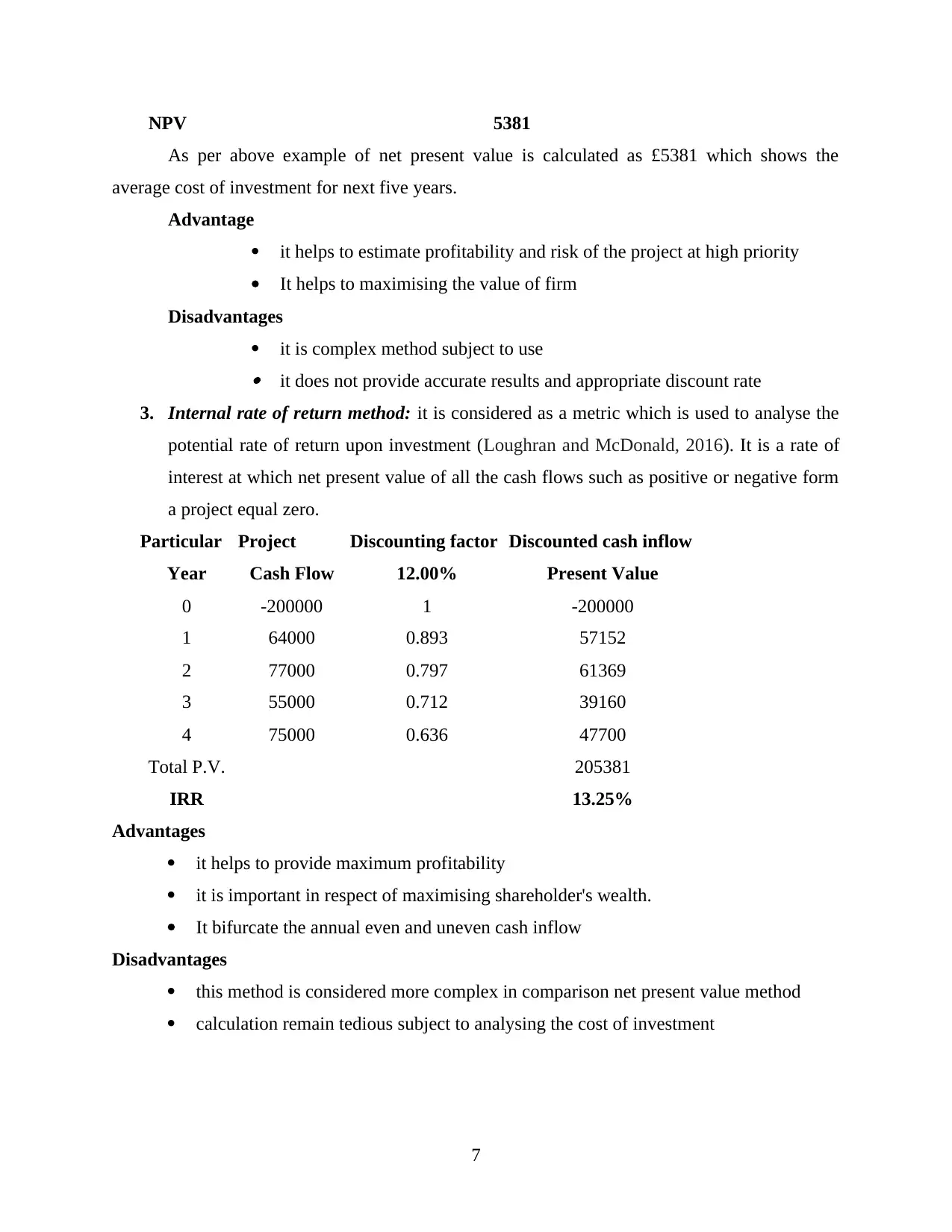
NPV 5381
As per above example of net present value is calculated as £5381 which shows the
average cost of investment for next five years.
Advantage
it helps to estimate profitability and risk of the project at high priority
It helps to maximising the value of firm
Disadvantages
it is complex method subject to use
it does not provide accurate results and appropriate discount rate
3. Internal rate of return method: it is considered as a metric which is used to analyse the
potential rate of return upon investment (Loughran and McDonald, 2016). It is a rate of
interest at which net present value of all the cash flows such as positive or negative form
a project equal zero.
Particular Project Discounting factor Discounted cash inflow
Year Cash Flow 12.00% Present Value
0 -200000 1 -200000
1 64000 0.893 57152
2 77000 0.797 61369
3 55000 0.712 39160
4 75000 0.636 47700
Total P.V. 205381
IRR 13.25%
Advantages
it helps to provide maximum profitability
it is important in respect of maximising shareholder's wealth.
It bifurcate the annual even and uneven cash inflow
Disadvantages
this method is considered more complex in comparison net present value method
calculation remain tedious subject to analysing the cost of investment
7
As per above example of net present value is calculated as £5381 which shows the
average cost of investment for next five years.
Advantage
it helps to estimate profitability and risk of the project at high priority
It helps to maximising the value of firm
Disadvantages
it is complex method subject to use
it does not provide accurate results and appropriate discount rate
3. Internal rate of return method: it is considered as a metric which is used to analyse the
potential rate of return upon investment (Loughran and McDonald, 2016). It is a rate of
interest at which net present value of all the cash flows such as positive or negative form
a project equal zero.
Particular Project Discounting factor Discounted cash inflow
Year Cash Flow 12.00% Present Value
0 -200000 1 -200000
1 64000 0.893 57152
2 77000 0.797 61369
3 55000 0.712 39160
4 75000 0.636 47700
Total P.V. 205381
IRR 13.25%
Advantages
it helps to provide maximum profitability
it is important in respect of maximising shareholder's wealth.
It bifurcate the annual even and uneven cash inflow
Disadvantages
this method is considered more complex in comparison net present value method
calculation remain tedious subject to analysing the cost of investment
7
⊘ This is a preview!⊘
Do you want full access?
Subscribe today to unlock all pages.

Trusted by 1+ million students worldwide

2. Compare the alternative investment option with practical example
As per the present scenario RCL Ltd has two options of investing the amount of capital
in new manufacturing facility in Reading or Bristol. It is seen that employees need to analyse the
effectiveness of project plans. Project first Reading contains the cost of worth £20 million which
provides the consistency of project for 9 to 10 years whereas another investment plans contains
the cost of £16 million which indicates towards the feasibility of 5-6 years.
Steve may choose alternative options such as acquiring of existing entity of same type of
business rather then investing the capital investment in new plant. It would helps Steve to
manage the department of organisation in order to maintain reliability of investment. RCL Ltd.
Can acquire the Brooks Ltd with £18 million capital investment. This is one of the alternative
method which will be remain beneficial for the organisation. This project have an expected
useful life up to 10 years.
3. analysis and recommendation subject to project plan
There are two projects are analysed in part 2 in section 1 viability of two capital
investments are measured with practical capital investment approach. Apart from it in second
option there is an alternative investment option is compared in respect of proposed expansion
plan.
As per analysis of investment plan in section 1 RCL should the Reading investment
proposal on the basis of expected life. Expected rate of return will be more in capital project of
Reading rather then Bristol project. Expected life of Bristol project is only 5-6 years where as
Reading project has expected life is 9-10 years.
As per second proposal it is evaluated that the capital investment of acquiring existing
business of same nature will be more beneficial of organisation.
CONCLUSION
This report is prepared in two parts which helps to determine the scope of financial
reports in respect of take finical decisions. In first part three major issues are elaborated subject
to evaluating the financial performance of organisation. Working capital, cash flow and profit
statements are analysed in first part. Second part covers the analysis of expansion plan for further
areas. Issues are noted in order to ascertain the viability of financial resources. Various type of
investment appraisal methods are discussed in this report subject to proposed plan.
Recommendations and analysis of affecting factors also discussed in this context.
8
As per the present scenario RCL Ltd has two options of investing the amount of capital
in new manufacturing facility in Reading or Bristol. It is seen that employees need to analyse the
effectiveness of project plans. Project first Reading contains the cost of worth £20 million which
provides the consistency of project for 9 to 10 years whereas another investment plans contains
the cost of £16 million which indicates towards the feasibility of 5-6 years.
Steve may choose alternative options such as acquiring of existing entity of same type of
business rather then investing the capital investment in new plant. It would helps Steve to
manage the department of organisation in order to maintain reliability of investment. RCL Ltd.
Can acquire the Brooks Ltd with £18 million capital investment. This is one of the alternative
method which will be remain beneficial for the organisation. This project have an expected
useful life up to 10 years.
3. analysis and recommendation subject to project plan
There are two projects are analysed in part 2 in section 1 viability of two capital
investments are measured with practical capital investment approach. Apart from it in second
option there is an alternative investment option is compared in respect of proposed expansion
plan.
As per analysis of investment plan in section 1 RCL should the Reading investment
proposal on the basis of expected life. Expected rate of return will be more in capital project of
Reading rather then Bristol project. Expected life of Bristol project is only 5-6 years where as
Reading project has expected life is 9-10 years.
As per second proposal it is evaluated that the capital investment of acquiring existing
business of same nature will be more beneficial of organisation.
CONCLUSION
This report is prepared in two parts which helps to determine the scope of financial
reports in respect of take finical decisions. In first part three major issues are elaborated subject
to evaluating the financial performance of organisation. Working capital, cash flow and profit
statements are analysed in first part. Second part covers the analysis of expansion plan for further
areas. Issues are noted in order to ascertain the viability of financial resources. Various type of
investment appraisal methods are discussed in this report subject to proposed plan.
Recommendations and analysis of affecting factors also discussed in this context.
8
Paraphrase This Document
Need a fresh take? Get an instant paraphrase of this document with our AI Paraphraser

9
1 out of 11
Related Documents
Your All-in-One AI-Powered Toolkit for Academic Success.
+13062052269
info@desklib.com
Available 24*7 on WhatsApp / Email
![[object Object]](/_next/static/media/star-bottom.7253800d.svg)
Unlock your academic potential
© 2024 | Zucol Services PVT LTD | All rights reserved.





